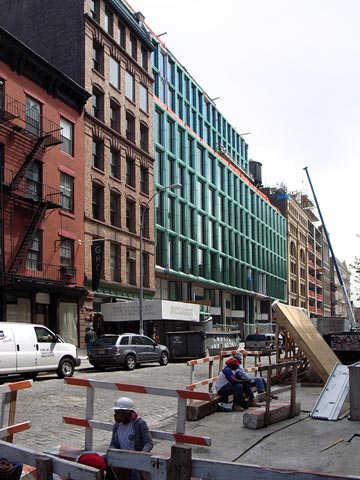In my comings and goings to and from my apartment/office on the east side, I often walk through Noho, the relatively small area of loft buildings hemmed in by the East Village, Greenwich Village, and Little Italy (Nolita). For years, the neighborhood was dotted with small, odd, seemingly temporary structures, auto shops, gas stations, diners, etc. And lots of parking lots. Some of this lack of cohesion can be explained by the building of the IRT subway way back in the early 1900s when Lafayette Street was ripped through the neighborhood to allow for the cut and cover construction of the tunnel. The demolition left narrow bits of property on each side of the street, which ended up being used, or barely used, for an entire century by the above hodgepodge of structures.
There’s lots more history and information to be had here.
In any case, the parking lots and slender strips of property are being developed in the current boomtown climate of New York. The most interesting arechitecturally is Bond Street between Lafayette and the Bowery. Several infill apartments buildings are going up simultaneously, the most notable of which is 40 Bond. Ian Schrager, the Studio 54 entrepreneur ( and tax evader) turned to real esate development after a stint in prison. His residential developments are boutique buildings with an emphasis on design and chic life style. 40 Bond is notable for being the first building designed by the Swiss architects Herzog & de Meuron, who are known for the Tate Modern in London and the de Young Museum in San Francisco.
40 Bond’s facade features molded green glass framing around the large windows, and along the street–yet to be assembled–will be a grafitti inspired frieze of cast aluminum. Whatever one thinks of the sleek Schrader packaging of the project, the building embodies the new emphasis on architecture (in the service of real estate) in New York. The other notable aspect of the project is the level of craftsmanship evident, and the richness of materials–in this case the glass framing–something fatally missing in much contemporary architecture.
